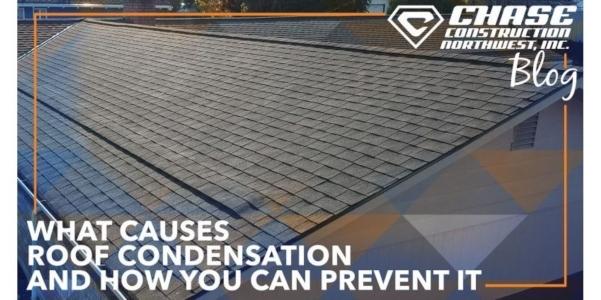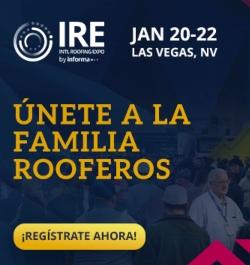What Causes Roof Condensation?

By Chase Construction Northwest, Inc.
Help your customers understand that just because their roof isn’t leaking doesn’t mean they are protected from moisture damage.
Moisture can be sneaky. The truth is that condensation is one of the chief forms of moisture damage in roofing systems.
The straightforward way of determining roof condensation causes is lack of ventilation. But that answer raises many questions, like how to vent roofs well enough or what to do when roofs can’t be vented.
There are two different roofing paradigms when it comes to these issues: one for steep slope and one for low slope. The physics are the same for each (obviously), but the concerns and practices for each differ.
In steep slope roofs with attic space, ventilation is a reasonable tool to counter the risk of condensation. But in low slope roofs with no attic space, ventilation is typically inadequate.
The Physics of Condensation
The air around us contains water in its gas phase (water vapor). Temperature determines the amount of water vapor air can hold. When temperature decreases enough, the water vapor condenses into its liquid phase.
Remember how the mirror fogs up when you step out of the shower? The mirror is a cold surface (condensation needs a surface), and the warm water vapor condenses as it lands on this cold surface. The same thing frequently happens in roofing systems and attics, causing all sorts of damage.
The temperature at which vapor condenses is the “dew point.”
Imagine outside temperature is 45 degrees and inside your home is 70 degrees. There will frequently be a dew point between those two temperatures, which means that at some point between the inside and outside of your home, water vapor condenses as hot travels to cold.
Roofs and attics are of particular significance since vapor can be carried by air, and air rises. Without adequate air barriers enveloping your home, warm air with vapor will contact a cold surface and condense.
Vapor diffusion is the method by which vapor flows through solid material. So, even if air travel is blocked, vapor can still travel through objects and condense on their cold surfaces.
For steep slope homes, the strategy for reducing the risk of condensation is by ventilating the attic. We want the attic temperature to be as close to the temperature of the outside as possible. If it is not, there is likely a dew point at some point in the attic (often noticed on underside of nails holding down shingles). This can result in a roof going bad before the roofing shingles go bad, because the sheathing can rot.
With enough attic ventilation (both intake and exhaust), the risk of condensation on the roof underside can be significantly reduced. But in that case, there is still a dew point somewhere between the conditioned living space and the attic.
With a vapor barrier enveloping the living space and enough insulation in the attic for heat transfer resistance, the amount of vapor that gets into the attic can be minimal. And the vapor that does can be swept away by the ventilated space.
Signs a roof may have condensation issues
Get into the attic. Is it warm? It should be really close to the same temperature as the outside
Perform the smoke candle test. Light a candle and put it up to the soffit intake ventilation. Find where that smoke goes. If it exits the mushroom vents near the ridge of the roof or out of a ridge vent, then ventilation may be good. Otherwise it is probably not.
Is the roof overly mossed? Sure, some moss can be normal, but if there is a lot or if it seems to be in spots it maybe shouldn’t be, condensation can be feeding it from below the roofing shingles.
Are there bird blocks? Sometimes these are adequate intake ventilation, but often they’re not. Smart intake vents like Cobra IntakePro may be needed.
Is insulation blocking the soffit vents along the eave line in your attic?
Addressing flat roofs with no ventilation
Most commercial roofs (and some residential) are flat or low slope and don’t have much ventilation. These roofs require a bit more sophistication to counter condensation.
As the roofing industry improves, understanding of condensation in roofing systems increases and our ability to solve it improves.
The strategy is to use a vapor retarder on the roofing substrate. There is some difference of opinion on whether a retarder or barrier is best. Because vapor does get through even the most well-designed systems, it is believed a retarder is best because they have some level of breathability that can allow vapor to exit more easily.
Overlapping rigid insulation should go in the middle and the roofing membrane over the top. This creates a roofing system with vapor retarder/barrier on each side and strong thermal resistance through the middle. With the dew point in the insulation, the idea is for there to be little diffusion of vapor to a surface on which to condense.
And when that does happen (because no system is perfect), the roofing membrane itself plays a pivotal role in reducing damage by how it heats up.
It is well understood that some amount of water just finds its way through so many large, flat roofing systems. But that water can dissipate seasonally (or daily) when the roofing membrane reheats by absorbing solar rays.
In recent years, white roofs for large, flat buildings have become wildly popular. White is very reflective and much of the solar radiation that hits it isn’t absorbed. The popularity of white roofs may be for environment-related concerns, but there’s an irony in that the reflective nature of white roofs may be causing unnecessary damage, which in turn costs energy to fix.
Gray is an option growing in popularity because of this. It is less reflective than white and does have some ability to reheat.
But it may be the case that the only way to robustly protect against condensation in most flat roofs is by using a dark material, like modified bitumen.
Even then, there isn’t true certainty. For homes and businesses alike, ventilating the living/working space may be required. Even the smartest roofing system can’t avoid condensation if there is too much vapor in the conditioned space.
Extra special thanks to the Roofing Contractor’s Association of Washington (RCAW). Their series of condensation and ventilation related classes at the annual trade show of 2019 was a brilliant move. When we saw the schedule, we were expecting them to be great. And the classes turned out better than that. Kudos to GAF’s James Willits, Owens Corning’s Rollo Gallion, and Wetherholt and Associates’ Ray Wetherholt for their informative presentations.
Get more educational and informative articles like this one delivered right to your inbox when you sign up for the RCS Week in Review e-newsletter.






















Comments
Leave a Reply
Have an account? Login to leave a comment!
Sign In